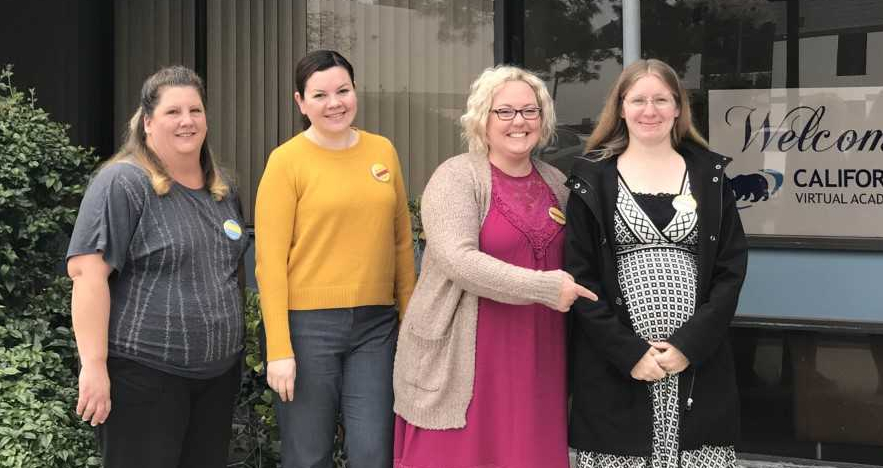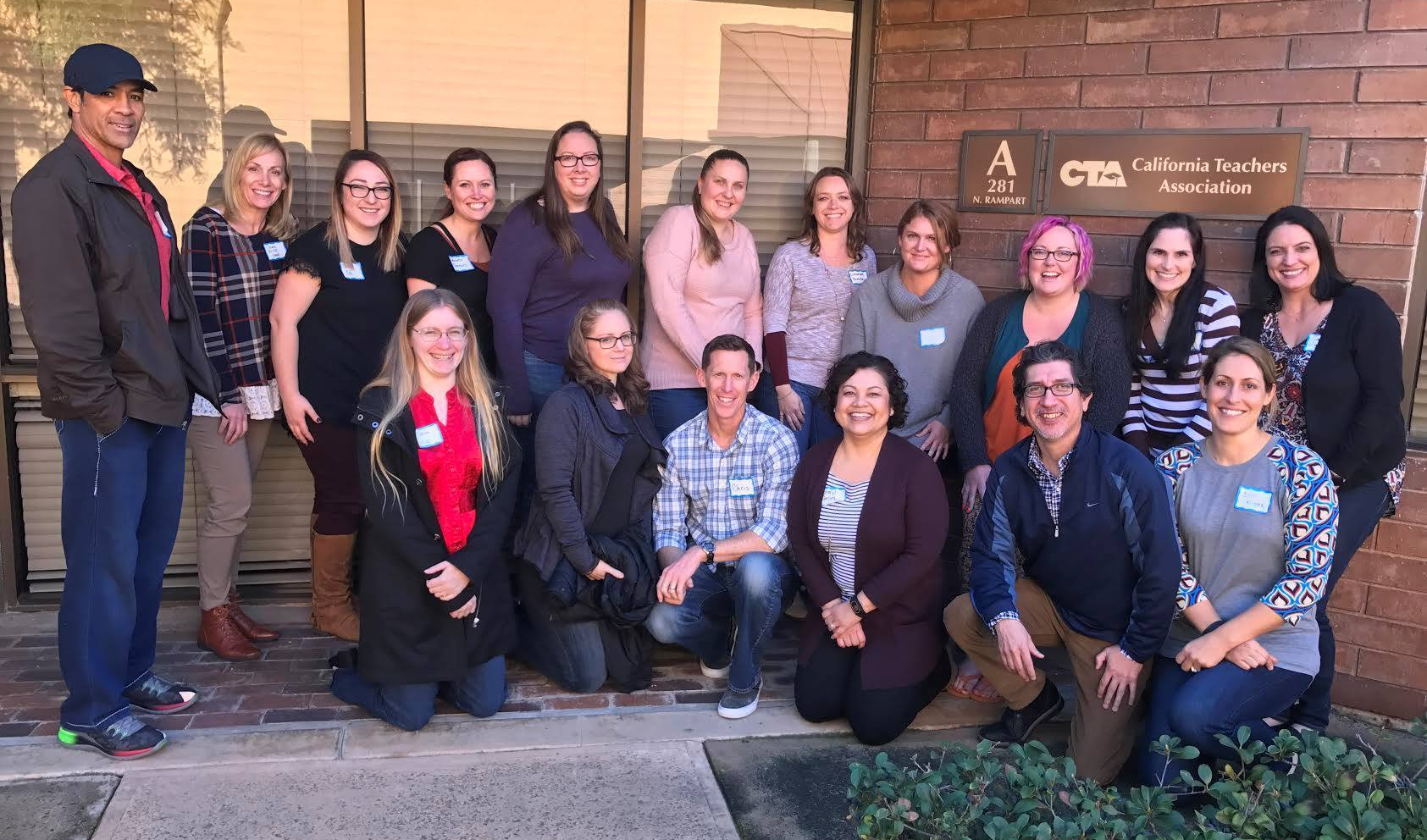In April, California Virtual Educators United (CVEU) members voted by an overwhelming 98 percent to ratify a contract agreement with California Virtual Academies (CAVA). CAVA completed its ratification votes May 11, making the virtual charter the nation’s largest online school with a collective bargaining agreement covering a unionized staff. The agreement, reached after more than a year of often contentious negotiations, comes after years of organizing work and tension with a union-averse employer whose profit-driven model had led to less than ideal conditions for both students and teachers.
CAVA is a network of schools operating in affiliation with K12 Inc., the nation’s largest presence in the online school market. K12 has been in business since 2000 and in California since 2002, but CAVA teachers felt its increasing focus on profits has resulted in deterioration of the instructional program, lack of resources for students, and underpaid, overworked and frustrated teachers.

The CVEU delegation at fact-finding. Back row, left to right: Janine Burns, Brianna Carroll, Kristin McCaffrey, Amy Koller. Front row: Sheryl Carruth, Stacey Mankoff, Amber Blodgett, Katie Jamreonvit.
That frustration led to a small group of CAVA teachers discussing the idea of forming a union, a daunting task given that at the time the school had about 750 teachers who were spread all over the state with limited opportunity to engage in person. In 2013 they reached out to CTA staff in the Sacramento area for advice. They formed an organizing team and began outreach to colleagues. They set up a closed Facebook group, which built solidarity and a sense of community, and gradually became a safe space for teachers to air concerns. Many of those concerns centered on ever-changing, top-down policies that didn’t benefit students.
Concern for students
Brianna Carroll is a fourth-year CAVA teacher and CVEU’s current and first union president. “Teachers were concerned about the instability their students were experiencing,” she says. “We also began discussing the reality that our low salaries and working conditions were making it hard for CAVA to keep teachers, creating an unstable environment for students. Every year we were losing more and more students and teachers.”
 “Changes in management at K12 and an increased emphasis on profits had led to changes at CAVA that shortchanged students,” says Sarah Vigrass, a 10-year CAVA teacher who has since joined CTA staff as a field organizer. “When I started teaching there, families would start the year getting these great boxes of art supplies, textbooks and curriculum, and teachers had time to build relationships with students and families. A lot of that went away. I even heard a K12 executive, in response to a parent asking to bring back physical textbooks instead of online versions that were hard for students to navigate, ask if the parent would be willing to pay for them. That’s just wrong. A family with a child in a public school shouldn’t have to pay for books.”
“Changes in management at K12 and an increased emphasis on profits had led to changes at CAVA that shortchanged students,” says Sarah Vigrass, a 10-year CAVA teacher who has since joined CTA staff as a field organizer. “When I started teaching there, families would start the year getting these great boxes of art supplies, textbooks and curriculum, and teachers had time to build relationships with students and families. A lot of that went away. I even heard a K12 executive, in response to a parent asking to bring back physical textbooks instead of online versions that were hard for students to navigate, ask if the parent would be willing to pay for them. That’s just wrong. A family with a child in a public school shouldn’t have to pay for books.”
Support for a union grew. CVEU stepped up its organizing efforts with regional staff development meetings and weekly organizing team meetings, while CAVA management tried to convince teachers that unionizing would destroy the school (in one case advising teachers to call the police if a union organizer came to their home).
Despite management opposition, in 2014 CAVA teachers overwhelmingly voted to have CVEU/CTA be their exclusive representative. That sparked a 17-month legal battle in which CAVA contended that its campuses were individual schools and therefore separate bargaining units, and that voting for CTA representation was not the same as voting for CVEU. In October 2015 the Public Employment Relations Board (PERB) rejected CAVA’s arguments, granting CVEU/CTA exclusive recognition. CAVA again appealed but was rebuffed by PERB in June 2016. In September of that year, CVEU and CAVA began negotiations for their first contract.
Long road to settlement
Coinciding with CVEU’s organizing efforts, public research studies and a state investigation into CAVA and K12 publicly confirmed the teachers’ concerns about the quality of education their students were receiving, showing that the K12 connection to CAVA was putting profits before kids, and that achievement levels and graduation rates were substantially below statewide averages for traditional schools.

CAVA teacher and CVEU President Brianna Carroll is based in Livermore. Photo: Scott Buschman
In 2016, that scrutiny led to a $168.5 million settlement between then-Attorney General Kamala Harris’ office and both companies over alleged violations of “false claims, false advertising and unfair competition laws,” including misleading parents about students’ academic progress, college eligibility, class sizes and other issues. Meanwhile, student and family concerns about the school led to a steep decline in enrollment and a teacher exodus in part due to layoffs. Today CAVA’s enrollment and teaching staff are down about a third from four years ago.
The 2½-year road from initial PERB recognition to a first contract settlement was not an easy one. CAVA’s delays in getting to the negotiation table and slow progress once talks began frustrated CVEU members, and some openly questioned — despite believing in the benefit of online learning for some students when done through a quality program — whether working in an environment where they felt so undervalued and disrespected was worth it. In November 2017, after more than a year at the bargaining table, CVEU members voted by 91 percent to authorize a strike if necessary.
Ensuring student and teacher success
That additional pressure worked. Tentative agreements were signed off on workload, achieving permanent job status (CAVA teachers had been “at-will” employees with no rehiring or due process rights) and salary. In April, with a potential strike looming, the only outstanding issue — teacher-student caseload — was finally resolved after a two-day state fact-finding hearing, and the tentative agreement was signed April 4. The historic contract made headlines in national news outlets, among them The Washington Post and The Atlantic, portending unionization efforts by other online charter teachers.
The success of their organizing and first contract has dramatically expanded CVEU’s membership. A pre-ratification recruitment drive (only union members were eligible to vote on the contract) has seen membership grow from 20 to 85 percent, by any measure a stunning increase.
“We are so proud of the hard work and commitment our teachers made in ensuring that our core values on work status, caseloads and workload were recognized,” says Carroll. “We now have a first contract that begins the process of fixing CAVA and ensuring the success of our students and teachers.
“We believe that there is an important place in education for alternatives such as online learning. That is why CVEU members are committed to making the changes needed so students have the best learning experience possible.”
iQ Teachers Association
The first union of virtual educators in the state to settle a contract
They may not be the largest, but they were the first. The iQ Teachers Association (iQTA) represents the 26 educators working for iQ Academy California – Los Angeles (iQLA), also a K12 Inc. online school. They settled their contract on Jan. 25, just days before a scheduled strike vote.
IQLA teachers decided to form a union for many of the same reasons that CVEU members did. “We were very aware of their struggles,” says iQTA Vice President Gemma Berkley. “We had similar concerns and knew changes needed to happen at iQTA.”

iQTA’s bargaining team, from left: Jennifer Finkbeiner, Sindia Jara, Gemma Berkley, Carrie Moore.
Current iQTA President Carrie Moore (on leave and unavailable for this article) reached out to CTA in August 2016 to begin organizing her colleagues to form the new union. “Carrie was the catalyst in starting the iQ Teachers Association and the force behind the constant movement through bargaining,” says Berkley. “She keeps us grounded and focused on our goal: a voice for iQ teachers and staff.”
Always mindful that their contract proposals reflected the needs and values of their respective members, Berkley and CVEU President Brianna Carroll kept in contact throughout both unions’ bargaining, and continue to learn from each other and share ideas. “We’re separate, but we’re mutually supportive unions,” says Berkley. “We learned from them, and our settlement, which may have come more quickly because we’re smaller and less of a financial impact on K12, may have helped move some things along for them.” During negotiations iQTA members were kept informed through virtual town hall meetings that provided bargaining updates, addressed concerns, and helped build solidarity.

CVEU and iQTA members meet in 2016 to strategize about parent, member and community outreach and to form bargaining committees.
The iQTA agreement was overwhelmingly ratified and is the first contract for a virtual school in California; iQLA is the first K12-affiliated school with a collective bargaining agreement.
At press time, a grievance had been filed over interpretation of the new salary schedule, and Berkley vowed to use the strength of the new union to pursue the matter to conclusion.
K12 and CAVA: A Profitable Business Model
K12 Inc. is a publicly traded Virginia-based company launched in 2000 by former Goldman Sachs banker Ron Packard and former U.S. Secretary of Education William Bennett using capital put up by Oracle CEO Larry Ellison and “junk bond king” Michael Milken. Other investors have included Secretary of Education Betsy DeVos.
Using California’s charter school law to find local authorizing public school districts, K12 set up its first CAVA schools in San Diego, Kern and Tuolumne counties in 2002. CAVA rapidly expanded to other counties and grew from an enrollment of several hundred students to over 15,000 at its peak.
Each of the individual CAVA schools was opened under a charter authorized by a school district in the county where the school is based. Those authorizing districts, in turn, have received millions of dollars annually for “oversight,” which usually means just a cursory review of CAVA budgets and, if pressed, an attempt to address or at least listen to public concerns.
CAVA and other virtual schools have no classrooms and no physical campuses. Students log on at home from computers (loaned to families by the school) to receive course work, view lectures, and interact with instructors. There are opportunities for occasional online group work, but for the most part the process is designed for students to work on their own. Parents sign off on logs to verify that time requirements for subjects like PE have been met. Depending on subject and grade level, student caseloads can run into the hundreds for teachers.
Despite the lack of physical classrooms and the related maintenance and other costs associated with brick-and-mortar campuses, CAVA receives the same level of taxpayer support for its students as other California schools.
CAVA schools, although claiming to be independent entities, are deeply tied to K12 financially and administratively. CAVA contracts with K12 for software, curriculum and administrative support services. What this means is that roughly half of the hundreds of millions of dollars in taxpayer funding CAVA receives has left the state and gone to K12 and its investors.
The Discussion 0 comments Post a Comment